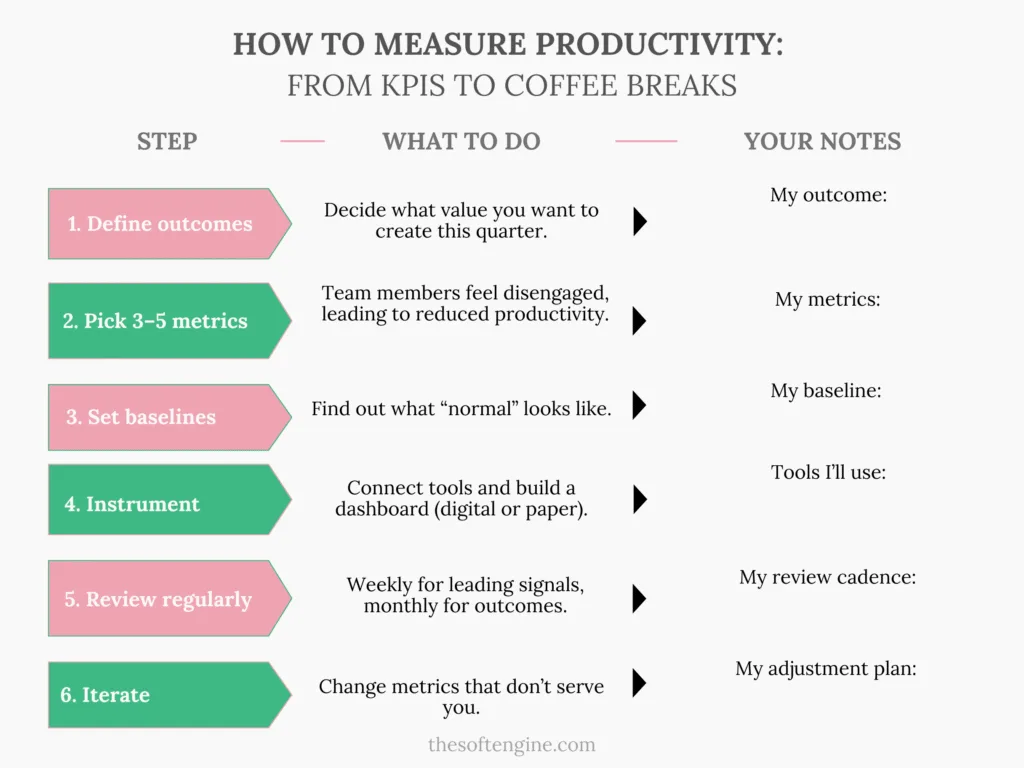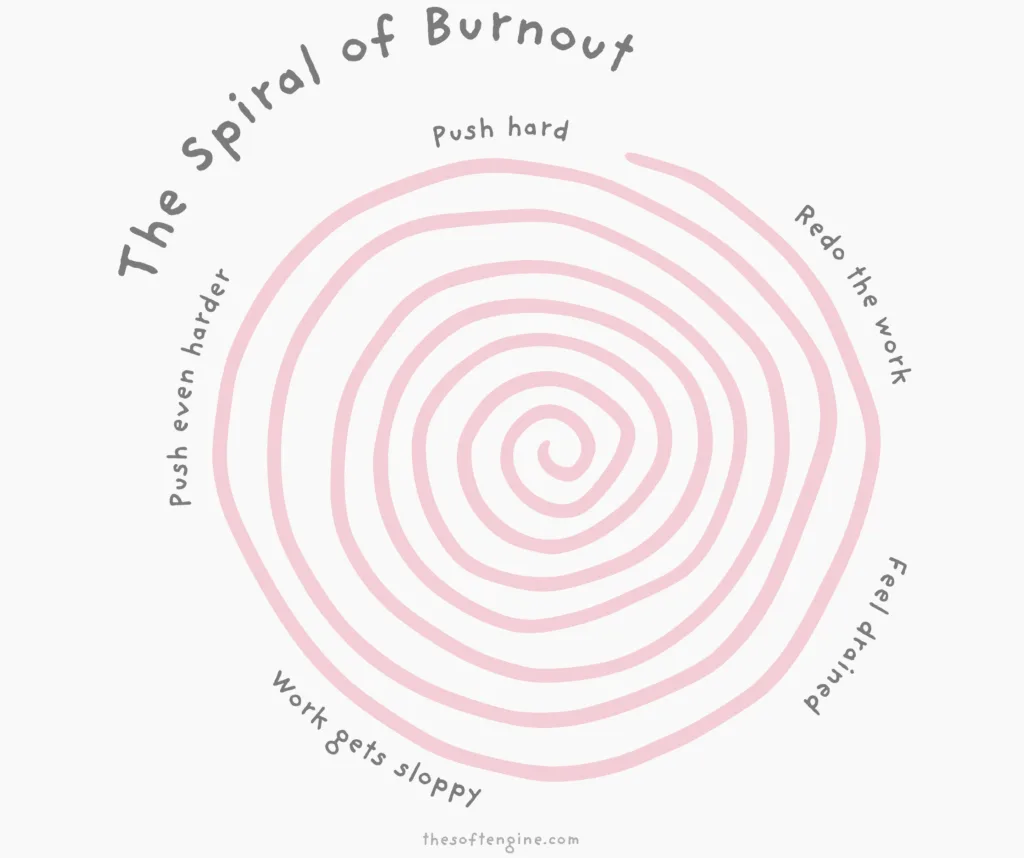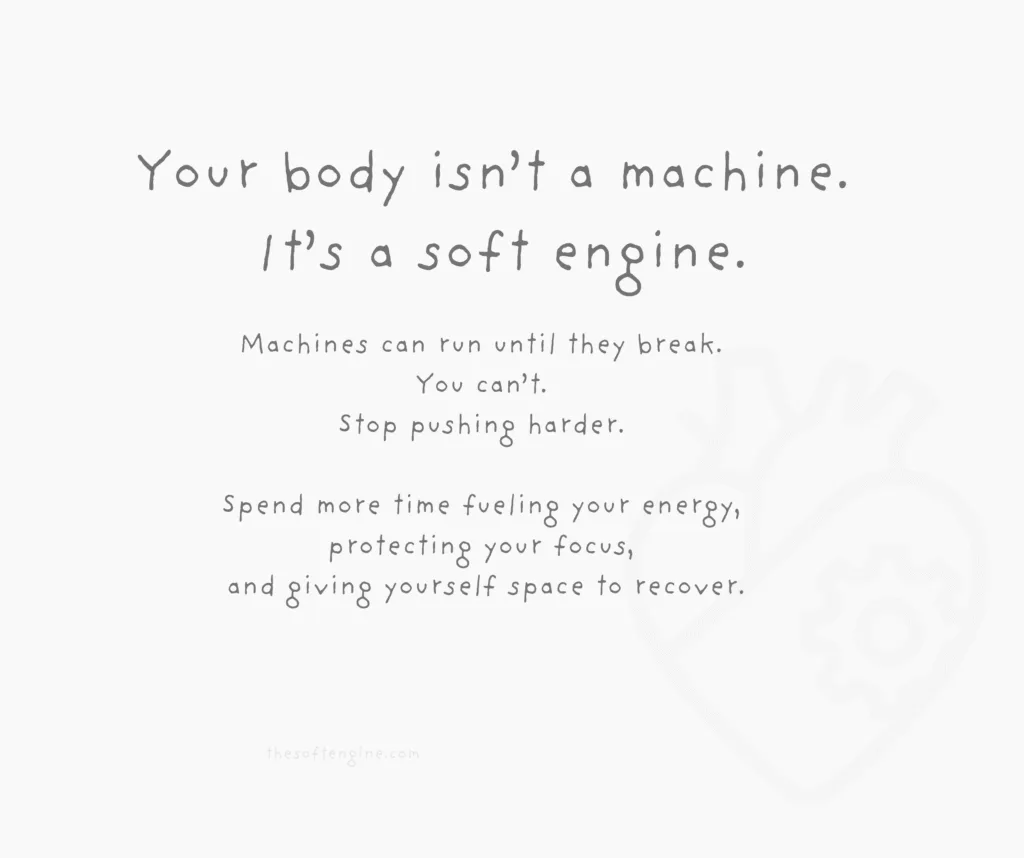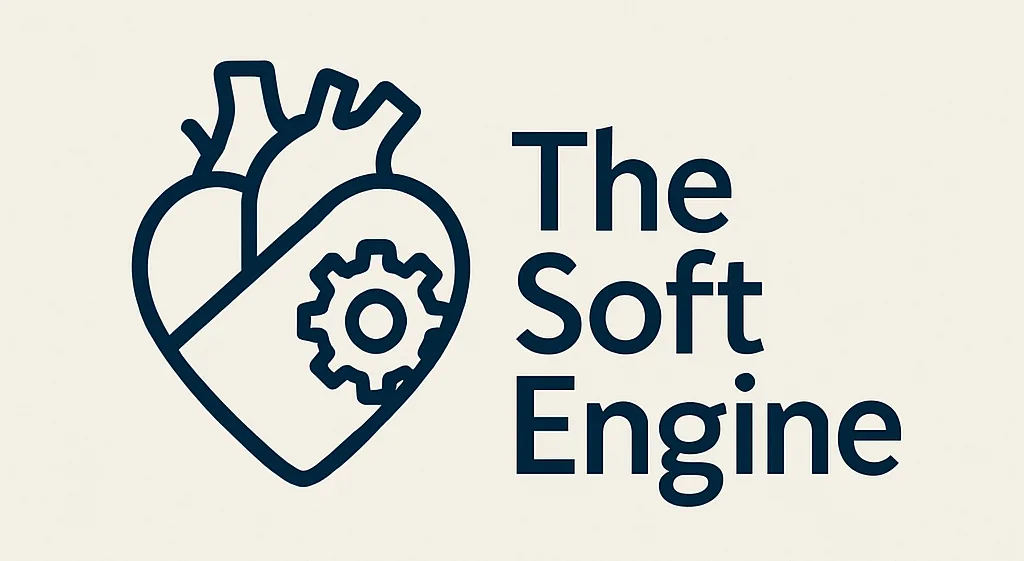Table of Contents
Let’s cut the bullshit: most productivity metrics aren’t helping anyone. Another dashboard, another green checkmark. It’s just another empty voice telling you you’re falling behind – in business and your personal development.
That’s what this guide is about. No vanity stats, no guilt-tripping. Just the real way how to measure productivity, for companies and for people, plus how to do it in a way that protects both quality and wellbeing.
We’ll also peek into the future — where AI will either fix this mess or add more noise, depending on how we use it.
What Is Productivity? The Clear Definition and Formula
At its simplest, productivity is output divided by input.
Economists track it as GDP per hour worked, i.e., a nation’s output compared to the labor behind it. Inside a company, the same math applies: define the value you create and divide it by the hours, people, or resources it takes to deliver.
But productivity isn’t just a business concern. On a personal level, it’s the same calculation: what you get done versus the time and energy you spend doing it.
A factory might measure units per labor hour; a consulting firm, revenue per employee. You, on the other hand, might look at how many meaningful tasks you finish in a focused morning versus a day lost to meetings and notifications.
The point? Productivity has to be defined in a way that reflects real value, whether that’s customer outcomes or the sense that you actually cleared your to-do list without doing a bunch of nothing.
ELI5: Lemonade Stand Math for Productivity
Think of it like this: you’re running a lemonade stand.
One afternoon, you sell 60 cups (output) in 3 hours (input). That’s 20 cups per hour. If you tweak your recipe and charge more, you sell the same 60 cups in 3 hours – but your value per hour just went up.
We have a whole guide explaining that here: Productivity: Explain Like I’m 5.
Choose the Right Level: Individual vs. Team vs. Company
Productivity has layers. You can measure the whole engine, or you can measure the moving parts.
But if you measure the wrong layer, you risk missing what actually matters – and if you only ever measure yourself like a machine, you forget that you’re a soft engine (eyy), not a robot.
In business, this is where many leaders slip up. Measuring only individuals risks sending the wrong signals, because the real work happens in collaboration and shared outcomes.
Hybrid work makes this even clearer. In a six-month randomized trial at Trip.com, employees who worked from home two days a week were 33% less likely to quit and reported higher job satisfaction — without any drop in performance or promotions.
In other words, focusing on outcomes instead of keystrokes tells a richer, more human story about productivity.
On a personal level, the same principle applies. Sometimes it’s right to measure yourself against the big picture (how close you are to your long-term goals).
Other times, you need to zoom in on the daily habits that make progress possible.
If you only ever measure yourself like a robot (inputs tracked, hours logged), you risk forgetting that you’re an engine, yes, but a soft one.
You need fuel, rest, and meaning to get through the hard work.
Productivity at the wrong level can make you feel like you’re failing when, in reality, you’re just measuring the wrong thing.
Forget the Fluff: Here’s How to Measure Productivity
There isn’t one magic number. The best way, at work or in life, is to use a mix of metrics, each showing a different side of the story:
- Output per hour. Classic measure: work ÷ time. A factory might track units per hour; you might track tasks done in a focused block.
- Revenue (or value added) per employee. Great when outputs vary. For business, it’s revenue. For you, it’s whether your work actually moves the needle.
- Cycle time and throughput. How fast things move through a pipeline – tickets closed, features shipped, errands done.
- Quality rates. Speed without quality just means rework. Fewer defects at work; fewer false starts in your own projects.
- OEE (Overall Equipment Effectiveness). The manufacturing gold standard: Availability × Performance × Quality. For individuals, it’s a check on your conditions: do you have the time, focus, and energy to work well?
Tools in action:
- Free: Jira or ClickUp for cycle time; Google Sheets for personal tracking.
- Paid: MachineMetrics or Evocon for OEE; RescueTime for personal analytics.
- Physical: Productivity planner (there are hundreds on Amazon) or a productivity timer, like a pomodoro timer.
Watch out for vanity metrics. Hours online or emails sent look busy but prove nothing. The best metrics (whether for a company or yourself) tie back to outcomes that matter.
A Practical How-To Measure Productivity Plan: From Baseline to Review Cadence
| Step | What to Do | Personal Example | Business Example |
| 1. Define outcomes | Decide what value you want to create. | Finish a side project without burnout. | Increase customer retention. |
| 2. Pick 3–5 metrics | Choose measures that track those outcomes. | Tasks completed, hours of deep work. | Net retention, churn %, NPS. |
| 3. Set baselines | Find out what “normal” looks like. | Track a week of habits before improving. | Past 12 months of retention data. |
| 4. Instrument | Connect tools and build a dashboard. | Google Sheets or a journal. | Tableau or Tability. |
| 5. Review regularly | Weekly for leading signals, monthly for outcomes. | Sunday reflection, monthly reset. | Weekly ops meeting, monthly exec review. |
| 6. Iterate | Change metrics that don’t serve you. | Swap “time spent” for “tasks done.” | Replace vanity sales KPIs. |
We made a template you can follow. Download the PDF for FREE of the image below:

The Productivity Mirage: What Happens When You Skip Quality and Health
Chasing raw output while ignoring quality and health is a trap. It creates a mirage of productivity – numbers that look strong on a dashboard but collapse under scrutiny.
When You Ignore Quality
Picture a team that ships 50 new features this quarter. Impressive—until you learn 20 had to be rolled back because of bugs.
That’s not progress; it’s wasted hours, angry customers, and trust slipping away.
For individuals, it’s checking 20 things off your to-do list only to redo half of them because they weren’t done right the first time. You’re just spinning your wheels.
When You Ignore Your Health
Burnout is invisible until it detonates. Inside a company, it looks like your best people are suddenly quitting, taking knowledge and momentum with them.
Personally, it’s staring at your laptop at 10 p.m., exhausted, making sloppy mistakes you’ll fix tomorrow, and dreading doing it all again.
In early 2021, Simone Manual experienced overtraining syndrome, a condition marked by an elevated resting heart rate, constant muscle soreness, loss of appetite, anxiety, and depression.
She simply couldn’t bring herself to go to the pool. Her body and mind were physically stopping her from doing more damage.
The truth is simple: productivity compounds, like interest.
Protecting quality means fewer do-overs. Protecting health means you keep showing up tomorrow. Ignore either one, and the curve doesn’t just flatten, it free-falls.
That’s the danger of the productivity mirage: by the time the cracks appear, you’re already bleeding time, talent, and energy you won’t get back.

Future Forward: The Next Chapter of Productivity
Let’s pause the what is, and lean into what could be. Right now, much of productivity is swallowed by low-value, repetitive tasks: emails, process handoffs, template tweaks.
AI isn’t making us lazy – it’s revealing how much busywork we’ve been doing. And that’s the first clue that what we measure is about to change.
Here’s what’s starting to shimmer on the horizon:
- Busywork goes away, and what we measure changes. AI is freeing up time to focus on what matters. In one study, workers reported that generative AI saved them 2.2 hours per week, or about 5.4% of their working time. That’s hours that used to vanish in process fluff. Imagine measuring your productivity not by hours tracked but by insights generated.
- Outcomes (not tasks) rise to the top. Executives now believe AI and automation can boost productivity by 10–30% in the next few years, with some expecting even higher gains. But that shift only happens if we stop counting tasks and start designing metrics that are outcome-first.
- Companies will redefine productivity — but unevenly. In healthcare, logistics, and other high-stakes industries, speed just isn’t enough. You have to measure accuracy, patient outcomes, or delivery quality. Forward-looking CIOs are already tailoring AI productivity metrics to their industry, rather than chasing generic numbers.
- Big picture: transformative economic shift. The endgame isn’t just trimming hours but a massive structural change. Goldman Sachs projects that AI could boost productivity by about 15% in developed economies once it’s fully integrated. That kind of shift rivals the industrial revolutions.
Conclusion
Measuring productivity isn’t about spying on people or drowning in dashboards. It’s about clarity.
The danger is chasing the wrong numbers. That’s when you get the productivity mirage – charts that look great until the cracks show and you realize you’ve been measuring busywork all along.
So start small. One goal. Three solid metrics. Review them often. That’s it. Simple, but powerful.
And if you’re wondering where you stand today, we’ve made it easy: take our Productivity Assessment. It’ll show you if you’re tracking the right things or if you’re accidentally rewarding noise.


